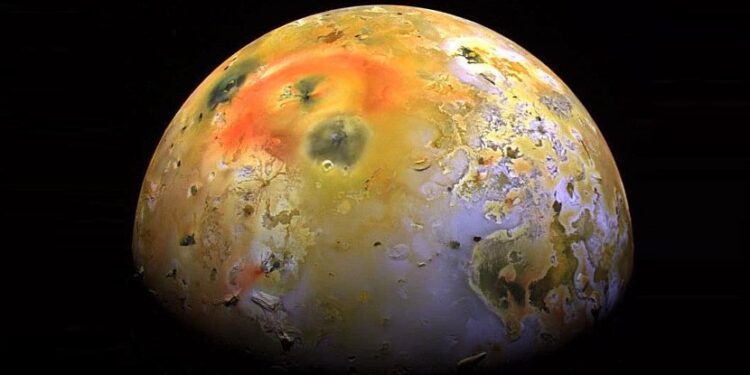Space exploration has once again delivered an extraordinary discovery—NASA’s Juno spacecraft recently captured the most intense volcanic eruption ever recorded on Jupiter’s moon Io. This finding not only confirms Io’s reputation as the most volcanically active world in the solar system but also provides unprecedented insights into planetary geology, tidal heating, and volcanic activity on alien worlds. With a massive hotspot larger than Lake Superior, this eruption has rewritten the record books, leaving scientists astonished and eager for more data.
Io’s Unprecedented Volcanic Eruption
Io has always been a celestial hotspot, quite literally. As Jupiter’s innermost Galilean moon, Io experiences extreme tidal forces caused by Jupiter’s massive gravitational pull and its interactions with neighboring moons Europa and Ganymede. These forces cause intense internal friction, generating enough heat to keep Io’s interior molten, leading to continuous volcanic eruptions.
During Juno’s December 27, 2024, flyby, the spacecraft recorded a gigantic volcanic hotspot near Io’s south pole, with eruptions more energetic than six times all of Earth’s power plants combined. The radiance of the eruption exceeded 80 trillion watts, making it the most powerful volcanic event ever observed on Io. NASA’s scientists described it as a game-changer for understanding planetary volcanic processes.
What Makes Io So Volcanically Active?
Io’s volcanic activity is fueled by a process called tidal heating. Unlike Earth’s volcanism, which is primarily driven by radioactive decay and mantle convection, Io’s interior is constantly being stretched and compressed by Jupiter’s gravitational forces. This flexing effect creates heat, which melts subsurface rock, leading to continuous volcanic activity.
The recent eruption detected by Juno provides real-time evidence of how tidal forces interact with Io’s interior, reshaping its surface and driving its fiery landscape. According to planetary scientist Scott Bolton, principal investigator of the Juno mission, this event is the most intense volcanic eruption ever recorded in our solar system, reinforcing Io’s status as the most geologically active body we know.
Comparing Io’s Volcanoes to Earth’s
While Earth’s volcanoes are powered by tectonic activity and magma upwelling, Io’s volcanic systems are vastly different. Instead of forming along tectonic plate boundaries like on Earth, Io’s volcanoes are distributed across its entire surface, erupting in a near-continuous cycle. Lava lakes, massive plumes, and sulfur deposits dominate Io’s landscape, creating a world that looks more like a hellish inferno than a typical rocky moon.
The largest volcano on Earth, Mauna Loa in Hawaii, spans around 5,271 km² (2,035 mi²), while Io’s largest known volcanic feature, Loki Patera, covers over 20,000 km² (7,700 mi²). However, Juno’s latest findings have revealed a new hotspot spanning an astonishing 100,000 km² (40,000 mi²)—five times larger than Loki Patera.
Why Is This Discovery Important?
Understanding Io’s volcanic activity is crucial for several reasons:
- Planetary Evolution – Studying Io’s volcanism helps us understand how tidal heating shapes celestial bodies, which could provide insights into exoplanets and distant moons.
- Comparisons to Early Earth – Io’s extreme volcanic activity may resemble Earth’s early geologic processes, offering clues about our planet’s volcanic history.
- Implications for Alien Worlds – The intense heat on Io raises questions about subsurface oceans and geological activity on moons like Europa and Enceladus, which may harbor life-supporting conditions.
How Juno Captured This Event
Juno’s JIRAM infrared imager played a key role in detecting the volcanic activity on Io. Despite being 74,400 kilometers (46,200 miles) away from the moon, Juno’s instruments picked up an enormous heat signature, so intense that it saturated the detectors.
NASA scientists believe this event is linked to multiple closely spaced hotspots, suggesting a vast subsurface magma chamber fueling the eruption. With continued flybys planned, Juno will allow scientists to track surface changes on Io over time and investigate whether Io’s volcanic eruptions follow predictable cycles.
Io’s Volcanic Features: The Giants of Lava
One of the most fascinating aspects of this discovery is how it compares to other known volcanic features on Io. Until now, the largest known lava lake on Io was Loki Patera, which spans 20,000 square kilometers (7,700 square miles). However, the newly observed hotspot dwarfs Loki Patera, covering a staggering 100,000 square kilometers (40,000 square miles).
Future Missions and Scientific Questions
The Juno spacecraft will continue regular flybys of Io until 2025, capturing additional data on its volcanic activity. NASA scientists hope to determine:
- How often major eruptions occur on Io.
- If the eruptions are connected to Jupiter’s gravitational changes.
- Whether Io has a global magma ocean beneath its crust.
Upcoming missions such as NASA’s Europa Clipper and ESA’s JUICE (Jupiter Icy Moons Explorer) will also gather data on Io’s interactions with Jupiter’s magnetic field and how its volcanic activity might influence other Jovian moons.
The Bigger Picture: What This Means for Space Exploration
Io serves as a natural laboratory for studying extreme volcanism beyond Earth. Understanding its geology, heat flow, and volcanic cycles could help scientists predict volcanic activity on exoplanets and improve models for habitability conditions elsewhere in the universe.
NASA’s findings also have implications for future human exploration. If we plan to explore volcanic moons like Io or colonize distant exoplanets, understanding extreme planetary environments will be crucial.
Conclusion
NASA’s Juno mission has provided an unprecedented look at Io’s extreme volcanic activity, marking a significant breakthrough in planetary science. The discovery of the most intense volcanic eruption ever recorded showcases the remarkable power of tidal heating and its effects on planetary bodies.



















